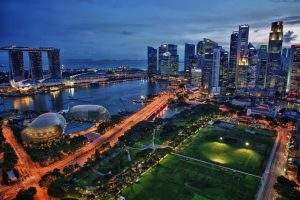 This week I find myself in Singapore to teach on a Custom Program for IESE Business School. The city is simply amazing for what it has accomplished, what it is today, and the model of future prosperity and harmony it offers for South East Asia.
This week I find myself in Singapore to teach on a Custom Program for IESE Business School. The city is simply amazing for what it has accomplished, what it is today, and the model of future prosperity and harmony it offers for South East Asia.
All of this comes, of course, at a political cost which it seems to me that the people of the city-state are happy to pay. A larger question is what this means for the rest of the region.
Singapore’s modern history goes back to the island’s selection by Stamford Raffles as the best location for a Brittish coaling station on the southern tip of the Malay peninsula. The English would go on to govern the island in one way or another until 1959 with the exception of the three and a half years it was under Japanese occupation during the second world war.
Singapore achieved self government in 1959, and after a brief merger with Malaysia, complete sovereignty and independence in 1965. By that time Primer Minister and leader of the People’s Action Party, Lee Kuan Yew, had established complete control of the island and its political life at the expense of his one time allies the communists.
Lee served as Prime Minister until stepping down in 1990 but established Singapore as one of the wealthiest cities in the region with a mix of pragmatic economic policies, pro-western geo-politics, and very tough internal administration.

The result was an economic and political experiment in the center of South East Asia which would prove to be even more important once China’s economy began to take off due to Deng Xao Ping’s reform program.
Today, Singaporeans enjoy one of the highest GDP per capita in the world ($53,000) and the city is full of incredible office buildings, shopping centers and more public art than I have seen in any other place.
It also appears to have very little overt ethnic conflict even though the city is home to a large mix of peoples and cultures including ethnic Chinese, Malay, Tamils and a small army of western expats.
Many western multinationals have chosen to locate their headquarters for Asia Pacific in the city due to its business friendly culture, great flight connections, and pleasant and safe environemnt.
Air quality, for example, is quite good compared to other asian cities except when Indonesian pollution from forest fires and palm oil plantations cover the city with a toxic haze. This was apparently a severe problem a couple fo years ago but residents tell me it is mostly over today due to work done between the two governments.

Lee handed the governement to his long time associate ,Goh Chok Tong who then passed the baton to Lee’s son, Lee Hsien Loong. The current Prime Minister is 65 and has announced he will step down when he reaches 70 in 2022. It seems his Ministers have already agreed to a smooth succession and according to an editorial in the Straights Times, this is a good thing and will guarantee the stability of Singapore for years to come.
For me the question that Singapore raises is if it is necessary to have a strong government with little or no tolerance for opposition to make progress in this part of the world? A friend was recently travelling in the Philippines and found very broad support for Rodrigo Duterte in that country despite, or perhaps, because of his extrajudicial killings of thousands of suspected criminals.
Here in Singapore the government is run on merit rather than association with a specific ethnic group and is considered a model for the developing world. The city atate’s success makes me wonder about how to bring such stability and prosperity to the rest of the region.


The merit system doesn’t have long roots outside the U.S. (and even in the U.S. much of that system is lost to the entitlement generation). I hope it succeeds and sets a great example for the rest of the world